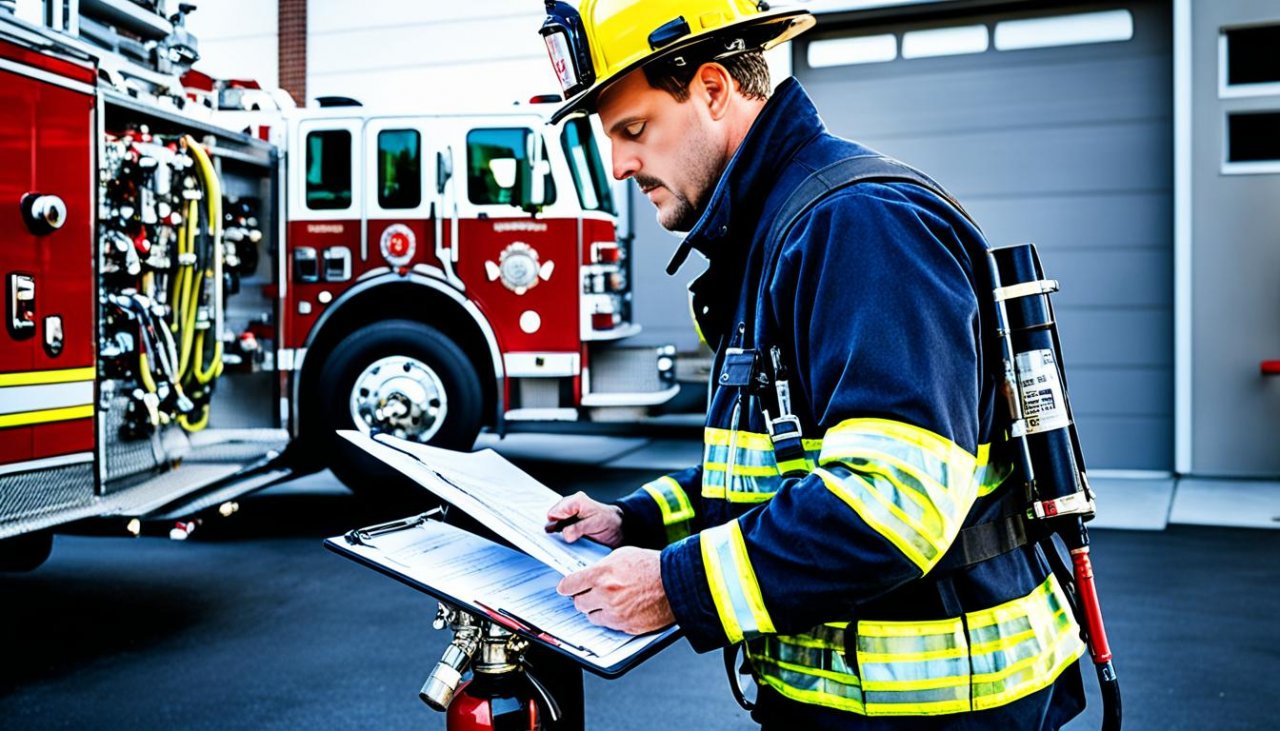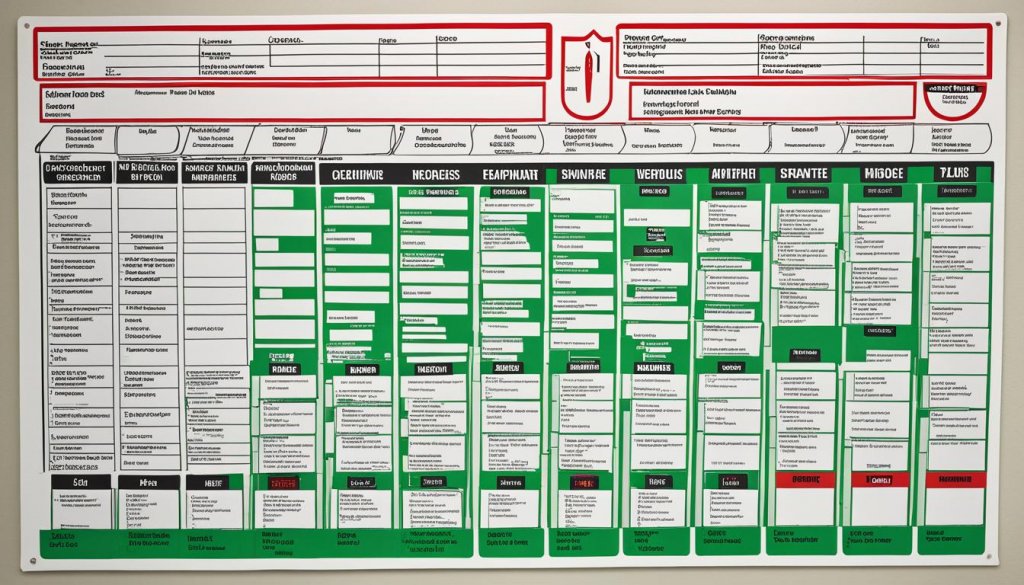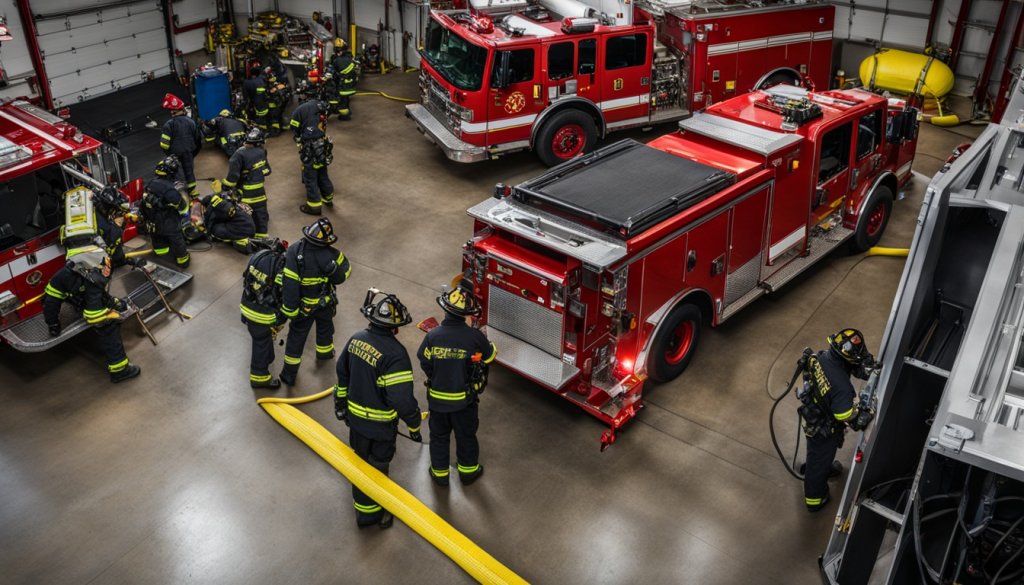Have you ever thought about how missing an inspection could lead to a big fire disaster? It’s key to keep track of fire equipment services for safety and to follow the law. By keeping good records of fire equipment maintenance, I can stop disasters before they start and make things run smoother.
Keeping up with fire safety records is very important. Following the best ways to document fire equipment helps me work better and lowers mistakes that could be dangerous. From smoke alarms to fire extinguishers, it’s vital to follow a set plan to make sure everything is ready. As I learn more about these best practices, it’s clear being ahead of the game is crucial in emergencies.

Key Takeaways
- Regular servicing and maintenance prevent equipment-related disasters.
- Routine checks must be conducted by licensed professionals for optimal readiness.
- Best practices in documentation reduce errors and create workflow consistency.
- Smoke alarms and fire extinguishers require thorough inspections at specified intervals.
- Proper training is essential for technicians to identify hazards effectively.
- Knowledge of local codes ensures fire equipment is always ready for use.
Understanding Fire Equipment and Its Importance
Fire safety equipment is key to keeping a place safe. It includes tools and systems that stop, control, and fight fires. Knowing about these tools helps make safety plans better and lowers the risk of fire dangers.
What is Fire Safety Equipment?
Fire safety gear includes devices that warn and protect people from fire risks. Important items are fire alarms, smoke detectors, fire extinguishers, and exit signs. Each tool is crucial for spotting fires early and helping people get out safely. Keeping these tools in good shape is important to make sure they work right and follow safety rules.
Types of Fire Protection Equipment
There are many kinds of fire protection gear, each with its own job in an emergency. Alarm systems quickly spot smoke or heat. Fire extinguishers and emergency lights help people find their way to safety. It’s important to check these items often, like weekly checks on fire extinguishers and yearly checks on alarms. Doing this keeps everything working well and avoids fines and higher insurance costs.
Why Documenting Fire Equipment Services is Crucial
Keeping records of fire equipment services is key to safety and following the law. It helps me spot problems like broken or not working devices. This includes things like hosereels, landing valves, fire extinguishers, and sprinkler systems. Spotting these issues early helps avoid fines or legal trouble.
Ensuring Safety and Compliance
Keeping safety records is vital for finding hidden problems. Things like leaks, blockages, or damage can make equipment less effective in an emergency. By checking things like hosereels, landing valves, fire alarms, and smoke detectors, I make sure they work right. Keeping records helps follow fire safety laws and teaches people about fire risks.
Facilitating Regular Maintenance and Inspections
Regular maintenance is crucial for fire safety. Keeping accurate inspection logs helps us stay ahead of safety issues. Checking fire exits and flammable material storage is key to preventing fires and keeping safe in emergencies. A good schedule means we can do inspections on time, making sure everything is ready for emergencies. This keeps people and property safe, showing why documenting fire equipment services is so important.
Key Elements of Fire Equipment Maintenance Records
Keeping detailed fire equipment maintenance records is key for safety and following the law. A good system helps managers keep track of all fire safety tools and appliances. This makes it easier to check their condition.
Name of Activity and Frequency
Every maintenance record should list the activity done, like testing fire alarms or checking smoke detectors. It’s also important to note how often these checks are done—weekly, monthly, or yearly. This helps follow the rules and lowers the chance of legal trouble from not keeping up with maintenance.
Date of Testing and Results
It’s vital to record the test date and the results. This shows who is responsible and helps track how well the fire equipment works over time. Detailed reports on fire equipment service help spot any problems or repairs needed. With careful records, I can fix issues fast and keep fire safety up to standard.

Documenting Fire Equipment Services: Best Practices
Keeping accurate fire service documentation is key for safety and following the law in any building. It’s important to have a detailed list of all fire equipment. This includes things like extinguishers and alarms, along with their install dates and upkeep records. A thorough inventory helps managers keep up with testing needs.
Maintaining Accurate Inventory
Managing your inventory right helps you follow rules like EC.02.03.05. This rule talks about what you need for fire alarm and suppression records. Important details include testing dates and outcomes. I organize my inventory so it shows how often things need checking.
This makes it easier to pass inspections and audits. It also helps us act fast if there’s an issue.
Using Standardized Documentation Templates
Standardized templates make keeping fire equipment logs better. They make sure reports are the same everywhere, helping everyone understand them easily. When I get ready for audits, I use templates with sections for different parts.
This way, I can quickly find what I need. The aim is to make sure our documents are up to law and help keep everyone safe.
Establishing a Regular Documentation Schedule
Having a plan for fire safety documentation is key to keeping fire equipment in top shape. A set inspection schedule makes fire safety record keeping easier and follows the rules. It makes sure each piece of equipment gets checked regularly.
Defining Inspection Intervals
It’s important to set clear inspection times for fire safety gear. Daily checks look at things you can see, making sure they work and are easy to get to. Weekly, fire alarms get checked to make sure they work right when they need to.
Fire extinguishers should be checked monthly to make sure they’re ready to go. And once a year, everything gets a full check to make sure it’s all working well and meets the rules.
Daily, Weekly, Monthly, and Annual Checks
Having a plan for daily, weekly, monthly, and yearly checks helps with fire safety records. Daily, check fire exits and alarms to make sure they’re ready. Weekly, test alarm systems to make sure they work.
Monthly, look at fire extinguishers to make sure they’re full and ready. And once a year, do a big check on everything to make sure it all meets the rules. This way, managers keep good fire safety records that follow the rules.
Utilizing Technology for Efficient Documentation
Using technology to keep track of fire equipment services makes things much easier. Many groups are now using software to manage their fire equipment maintenance records better. This move to digital helps with scheduling checks, updating records, and reporting on them.
Software Solutions for Record Keeping
Document Management Systems (DMS) cut down on the costs of handling documents. Office workers spend 30% to 40% of their day looking for printed papers. This can lead to labor costs of up to $220 for making new copies. With a DMS, I can automate the process of keeping records, make storing documents easier, and reduce the work in managing fire equipment service documents. Tools like InspectNTrack, with barcode scanning, help me schedule, track, and document inspections easily.
The Advantages of Digital Documentation
Switching to a software-based DMS brings many benefits. It saves space by reducing the need for file storage. This means more room in the office for other things. Searching for documents quickly boosts productivity a lot.
Staff and clients are happier because they get information faster. Automated reminders and tracking help keep up with regulations. This ensures all checks are done on time, keeping fire equipment maintenance records up to date.
Fire Safety Documentation in Different Environments
Fire safety documentation is crucial in various settings. Each place has its own set of rules to follow, ensuring safety and meeting standards. In commercial areas, keeping detailed records is key to follow fire codes and insurance needs. This documentation protects employees and visitors by ensuring regular checks and upkeep of safety steps.
Commercial Properties
For businesses, it’s important to have a fire safety plan checked every 90 days for current staff and when new people start. Regular checks on fire gear make sure it works right. My safety plans include important parts like how to evacuate, who to call for help, and where exits are.
Fire drills are done at least once a year to test our readiness. They also teach everyone how to get out safely.
Healthcare Facilities
Healthcare places need extra focus on fire safety documents. Groups like The Joint Commission set strict rules for keeping records to keep patients, staff, and visitors safe. My fire safety plan must have risk assessments, emergency steps, and where to go in an evacuation.
Fire drills are key to being ready. I also have a team focused on making sure we always meet the latest rules. This makes the place safer and builds trust with patients and staff.
Regulatory Standards and Compliance Guidelines
It’s crucial for businesses to understand fire safety regulations. These rules help guide how to keep fire safety documents and follow safety rules. Staying up to date with national and local standards is key for managing risks well.
National Fire Protection Association (NFPA) Standards
The NFPA sets clear standards for fire safety documents. Following NFPA rules means keeping detailed records, which is important for audits. For example, NFPA rules cover how to handle and store flammable materials safely.
Sections 1910.106 through 1910.110 give guidelines for moving and storing dangerous substances. It’s important for companies to focus on fire safety documents to meet these standards.
State and Local Regulatory Requirements
State and local rules also affect fire safety, and they can vary. These rules often follow national standards but may have their own rules. For instance, some states require hot work permits for welding in flammable areas under Section 1910.252(a).
This kind of rule is key for legal compliance and keeping the workplace safe. Fire safety documents must include these local rules. So, facility managers need to keep up with these changes to stay ahead.
Common Challenges in Documenting Fire Equipment Services
Documenting fire equipment services has its challenges. One big problem is losing information. This happens when records aren’t kept right. Using only paper can lead to documents getting lost or not found.
To fix this, using a digital system for fire safety records is key. This way, important info is easy to find and keep safe. It makes sure nothing important is missed.

Another big challenge is making sure staff knows how to document services right. If staff isn’t trained well, they might miss important steps. Regular training helps them follow the rules better. This keeps records accurate and helps meet safety standards.
Conclusion
Documenting fire equipment services is key to good fire safety management. It helps meet safety standards and keeps fire protection systems reliable. Keeping up with maintenance records is crucial for protecting lives and property.
Using modern tech makes documenting easier and keeps records accurate. Digital tools help us stay on top of maintenance and updates. Knowing the rules helps make sure our records are correct, making our safety efforts more effective.
Training staff and following a set schedule helps us meet our safety goals. Clear communication is important for sharing important info with our teams and others. This focus on safety and documentation builds trust and readiness for emergencies.
See how FieldAx can transform your Field Operations.
Try it today! Book Demo
You are one click away from your customized FieldAx Demo!
FAQ
What is the importance of documenting fire equipment services?
Keeping records of fire equipment services is key for safety and following the law. It helps keep track of checks, tests, and upkeep.
What types of fire safety equipment should be documented?
You should document fire and smoke alarms, extinguishers, and emergency exit signs. Also, include any tools for preventing and fighting fires.
How can I ensure effective fire equipment maintenance records?
For good maintenance records, list the activity done, how often it’s done, test dates, and the findings.
What are the best practices for fire service documentation?
Keep an up-to-date list of all fire safety gear. Use standard forms for notes. Set a schedule for checking and maintaining equipment.
Why is it crucial to regularly inspect fire equipment?
Checking fire gear often makes sure it works right and meets safety rules. This protects people inside and follows the law.
How can technology improve fire safety documentation?
Tech makes documenting easier with software for keeping records, scheduling checks, and sending reminders. It also makes compliance documents easy to find.
What challenges might organizations face in documenting fire equipment services?
Problems include losing info if it’s not stored right and needing staff training for the right documentation.
How often should fire equipment inspections be performed?
Check times vary by equipment type. Do daily checks on visible gear, weekly on alarms, monthly on extinguishers, and yearly full checks.
What regulatory standards should I be aware of for fire safety documentation?
The National Fire Protection Association (NFPA) has key standards for documenting fire safety. Local fire codes might also have their own rules to follow.
In what environments is fire safety documentation particularly critical?
It’s very important in commercial places to meet fire codes and insurance needs. It’s also key in healthcare settings due to strict safety rules.
Author Bio
Co-Founder & CMO at Merfantz Technologies Pvt Ltd | Marketing Manager for FieldAx Field Service Software | Salesforce All-Star Ranger and Community Contributor | Salesforce Content Creation for Knowledge Sharing






